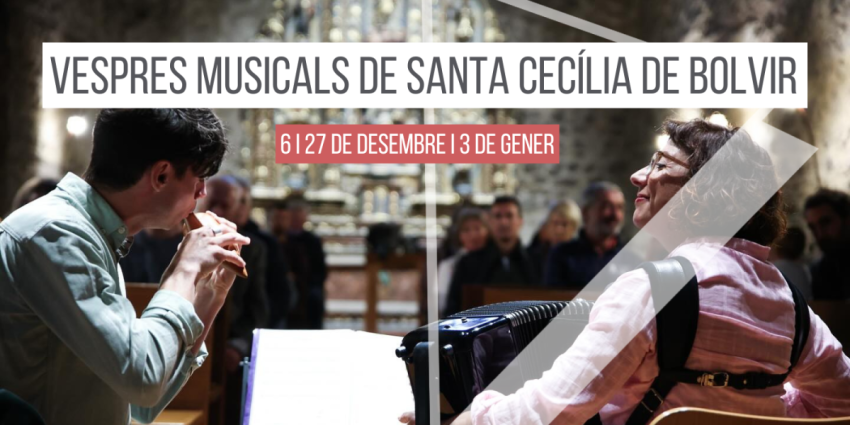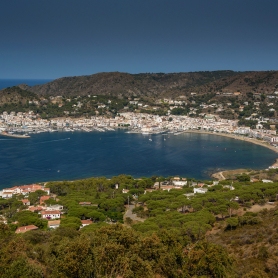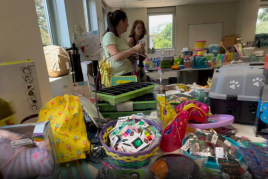Route through the sources and heritage of Caldes de Malavella

On this route we suggest you get to know the thermal springs and heritage of Caldes de Malavella in depth.
Are you up for it?
Roman Baths of Puig de Sant Grau
1st century Cultural Asset of National Interest. They are the best preserved remains of the Roman municipality of AQUAE CALIDAE, now Caldes de Malavella.
.jpg) The Roman thermal building of Sant Grau was built around 50 AD on a previous spa, from the 2nd-1st centuries BC, which was largely demolished and of which we know very few vestiges (remains of a paving, of some wall with arches, a small part of the façade and a small swimming pool).L'edifici from the 1st century AD, on the other hand, is conserved in a remarkably complete way.
The Roman thermal building of Sant Grau was built around 50 AD on a previous spa, from the 2nd-1st centuries BC, which was largely demolished and of which we know very few vestiges (remains of a paving, of some wall with arches, a small part of the façade and a small swimming pool).L'edifici from the 1st century AD, on the other hand, is conserved in a remarkably complete way.
You can still see the working mechanisms of the water almost intact. The building consists of a central rectangular pool (natatio), measuring 7.90 by 6.65 meters, with stepped access, and a series of chambers around it to receive curative treatments. There are three spaces in the back, initially it was thought that they were bathtubs, but these are rooms where oils were taken. Its characteristics are eminently salutiferous, probably linked to the cult of Apollo or some other disease-healing divinity.
In medieval times the spa continued in operation. Two new pools occupied the space of the old sacred room, while the circulation of the water accumulated calcareous sediment on all the south and east sides of the building. Its structures were used in the 14th century to build the Caldes castle, but the spa functions of the Roman building, converted into a hospital, still lasted until the 19th century.
The Puig de Sant Grau
I-XIX centuries. Small promontory where there are several hot springs of Caldes, which since ancient times were exploited with the construction of Roman baths. In medieval times, the mountain was occupied by the castle of Caldes; currently part of the wall and towers remain.
The chapel of San Grau, s. IX, which gives the place its name, was the parish church of the Villa until it became obsolete due to population growth and the fact that it was built in an area with strong springs of thermal water, since it caused the bodies of the cemetery did not decompose, but was mummified. Then, it was decided to build the new Church of San Esteban, 11th century, outside the walls. From this moment on, the chapel of St.Grau was the place where the common people of the town met; the trustee, etc.
In the 19th century, the industrialist Pau Estapé Maristany acquired a large part of the mountain and had the "Imperial Water" bottling plant built in the current Plaza del Agua. Taking advantage of the influx of vacationers to the seaside resort of Caldes, Mr. Estapé adapted the space to promote his product. In addition to carrying out the first campaign of archaeological excavation of the Roman baths there, a modernist garden was created that integrated the sources of San Grado or de la Roqueta and that of the Hospital in neoclassical style temples. With the crisis of the summer phenomenon, the whole complex followed a process of advanced deterioration, until a few years ago the Caldes City Council acquired it and adapted it.
The Castle and The Medieval Walls
 XII century. Medieval castle built on the remains of the Roman baths. It was demolished between the 18th and 19th centuries. Currently only part of the wall and towers remains as testimony.
XII century. Medieval castle built on the remains of the Roman baths. It was demolished between the 18th and 19th centuries. Currently only part of the wall and towers remains as testimony.
XII-XIV centuries. The town of Caldes had a wall that defended the population since the 14th century. Several sections are preserved, located in Cal Ferrer de la Plaza, in the hermitage of Sant Grau and the canal that follows the source of the Mine. The facing of the walls is made of squared ashlars arranged in rows and interspersed loopholes. The castle had its own wall of older origin, of which three defensive towers are preserved, one built on the remains of the Roman baths.
History of water bottling
The first industrial bottling that we have news of is from 1870. It was then that the Pla and Deniel family obtained permission to export medicinal water under the name "San Narciso".
Around 1880, Dr. Modest Furest i Roca acquired the land of Monte de las Ánimas to exploit the Grande, de la Cantera, Chica and del Hígado springs. Initially marketed under the name of "Agua del Puig de las Almas" in 1891 it took the name "Vichy Catalán". Soon the bottling plant achieved remarkable success.
At the end of the 19th century, Puig de Sant Grau was acquired by the industrialist Pau Estapé Maristany, who had the "Imperial Water" bottling plant built in the current Plaza del Agua. The project is complemented by the adaptation of the space and the construction of a modernist garden with the aim of promoting its product.
Finally, the Soler spa and the Prats spa bottled the water from the Mina fountain before the Civil War, with the names "Agua del Balneario Prats" and "Fuente Cataluña", respectively. After the war, the two companies merged to bottle "Agua Malavella", which in 1985 was acquired by SA Vichy Catalán.
Crossing of Ancient Roads
XIV-XVIII centuries. The intersection of the current streets of Libertad and the Small Square was in medieval times the nucleus of the town of Caldes. The road that went to the north led to Girona, the one to the east went to Cassà and Llagostera, the one to the west was the Camino Real de Santa Coloma de Farners and the one to the south was the Camino Real de Vidreres.
Each of the roads had an exit from the walled city from the respective portals, of which there are practically no traces. The only evidence that is preserved is located under the section of wall attached to Cal Ferrer de la Plaza, where the remains of the doorway of the Girona portal are located. The cross that is engraved in one of the houses of the crossing is a testimony of this ancient intramural enclave.
Mine Fountain and Municipal Laundries
The Fuente de la Mina is a source of thermal water, also known by the name of Rayo de Mel. It appeared as a result of the construction of a mine, which was done to dry out a marshy field.
During the 1840s its hot water was channeled underground to some bathhouses, which were the antecedents of the Prats and Soler spas. The water from the source was bottled for consumption by the Prats Spa under the name of "Agua del Balneario Prats" and by the Soler Spa as "Fuente Cataluña", until both merged under the name "Agua Malavella". Finally, in 1985 it was acquired by Vichy Catalán. The water gushes out at about 60 ºC and has recognized properties; That is why the presence of people from the region to take it is common.
Nearby washes are filled with thermal water that rises from the source, and throughout the region it was renowned for its suitability for doing laundry. This is the origin of the toponym of the Riera del Lejía, which runs ahead and collects the water.
The boulevards and the summer houses
 At the beginning of the 20th century, summer houses began to be built south of the Caldes nucleus, with a tree-lined promenade as the backbone. The walk, promoted by the Barcelonan Bartolomé Recolons, became a very popular place for the people of Barcelona who came to take the waters in the town.
At the beginning of the 20th century, summer houses began to be built south of the Caldes nucleus, with a tree-lined promenade as the backbone. The walk, promoted by the Barcelonan Bartolomé Recolons, became a very popular place for the people of Barcelona who came to take the waters in the town.
The houses that were built were strongly influenced by Modernist and Noucentista aesthetics, with distinctive decorative motifs such as moldings, winding gables, and pottery and wrought iron work. Good examples are the houses Mas y Ros, Motlló, Chalets de en Vilar and Bell-Estar, as well as the Antoni Mas villa and Colonia Rodríguez.
The boulevard was extended with a new wooded section, promoted by the owner of the neighboring farmhouse of Can Rufino. The construction model of this area was of large isolated towers, among which the Villa Rosario and the Torre de Can Sala stand out.
Other interesting modernist houses in the urban center: Quintana, Perxachs, Manegat, Pla y Deniel, house of the Poet Matheu, Casa de les Punxes, Bonanova, Torre de los Pájaros.
Parish church
11th-17th centuries. 11th century church dedicated to San Esteban. Of its origins, it only conserves the large Romanesque apses, in the Lombard style, and the basilica floor plan. It has been reformed several times and what we see today is mostly from the 17th century. The façade is in the Renaissance style and on both sides of the door, in the lower part, you can see one of the symbols of Caldes, large coppers or pots.
The Church is in the center of the square of the same name and is surrounded by modernist, neoclassical and eclectic buildings; the highlight is Casa Quintana. In the surrounding streets, we can find more emblematic buildings such as the Municipal Theater-Casino.
The farm and the source of the Cow
La Granja is an urbanization project started in the 1920s that contemplated the construction of a garden-city for the Caldes holidaymakers. According to the plan, the stately towers had to be accompanied by landscaped spaces, with a public park that would be the social center.
In a first phase of urbanization, six Noucentista style towers were built, among which the Villa Catalina (Tower No. 1), the Vicaría (Tower No. 2) and the Tower of the Horse (Tower No. 5) stand out. The public park was named after the pre-existing fountain, and a well and a picnic area known as the Casinet were built. The new source of the Cow is a modernist style construction, with sgraffito walls and a tile with the vault that gives it its name represented, crowned by a glazed ceramic dome. The urbanization project of La Granja did not prosper due to the crisis of the summer phenomenon and the outbreak of the Civil War.
It is a pleasant, quiet space and the best place to cool off in summer.
Prats spa
XIX-XX centuries.
Spa built between the end of the 19th century and the beginning of the 20th. The Prats family conceived the spa center as a large building in an eclectic style, with facades of symmetrical composition profusely decorated with classical motifs such as, for example, pilasters, garlands and flowers.
The hot springs of Caldes de Malavella have been known since Roman times. Its healing properties are appropriate for the treatment of rheumatic diseases, dyspepsia, hepatitis, fractures, wounds, and at the same time they are recommended to regulate disorders of the digestive, urinary and circulatory systems.
The antecedent of the Prats Spa is a small thermal establishment founded by the Prats family, taking advantage of the water from the Mine Fountain. The growing phenomenon of summer holidays led to the construction of the current building in the center of the town during the second half of the 19th century. This new building, with an eclectic taste, characterized by the use of architectural elements from different periods, had to be extended in 1912, following the project of the architect Eusebi Bona. It was then that the old access cover was replaced by the current one. Next to the thermal establishment, several booths were built to house customers, which were demolished a few years ago.
The Prats Spa bottled "Agua del Balneario Prats" on a small scale, until the increase in demand for sparkling water made the Prats spa and the Soler spa merge to create a new bottling called "Agua Malavella", from the water from from the Fountain of the Mine. Then there was a change in the consideration of Caldes water: in addition to consumption aimed at medicinal treatments, from that moment on it was considered table water, with the consequent increase in demand. The bottling plant was acquired in 1985 by the company SA Vichy Catalán.
Vichy Catalán Spa
XIX-XX centuries. The Vichy Catalán Spa was promoted by Dr. Modest Furest i Roca, who in 1880 bought the land of Puig de las Almas. The objective of this acquisition was to exploit thermal water sources, which consisted of the construction of a bottling plant and "on-site" baths. The water from the Grande, de la Cantera, Chica and del Hígado springs was initially marketed under the name "Agua del Puig de las Almas", already declared of public utility at that time.
In 1891 the water adopted the name "Vichy Catalán", by analogy with the renowned medicinal waters of the French spa. That same year, Dr. Furest consolidated the project with the construction of a spa, commissioned by Gaietà Buïgas and Monrabà.
The spa was designed as a building of monumental dimensions, in a modernist style and markedly Arabizing inspiration. It consists of two different parts that form a "T". An interior patio with a fountain stands out, in front of which there is a chapel dedicated to San José and San Esteban, built under the influence of modernist aesthetics.
Camp dels Ninots route
 Signposted visit to the paleontological site of Camp dels Ninots, declared a Cultural Asset of National Interest. Under the cultivated fields, one of the few deposits is hidden that allow the reconstruction of an entire ecosystem of about 3.1 million years ago, specifically from the period known as the Upper Pliocene.
Signposted visit to the paleontological site of Camp dels Ninots, declared a Cultural Asset of National Interest. Under the cultivated fields, one of the few deposits is hidden that allow the reconstruction of an entire ecosystem of about 3.1 million years ago, specifically from the period known as the Upper Pliocene.
The toponym of Camp dels Ninots comes from ancient times, from when many Caldenc went to look for what they called dolls: some stones (menilitic opal) with curious, kidney-shaped shapes, with which they played to imagine different figures. Scientific work carried out since 2003 has made it possible to recover animal fossil remains; birds, fish, amphibians, reptiles and mammals such as bovids or tapirs, and plant remains such as leaves, trunks and pollens. Thanks to these studies, it is known that the site is located in an ancient volcano, in the crater of which, when the volcanic activity ceased, a lake was formed.
Virtual guided tour at Camp dels Ninots: https://www.youtube.com/watch?v=zD3Ng5va1hI&t=69s
Source: Caldes de Malavella City Council
What to do
Museu Trias de la Galeta
Santa Coloma de Farners (a 11.5 Km)The Trias de la Galeta museum is the fruit of the Trias…
1881 Hotel Balneari Vichy Catalan
Caldes de MalavellaThe bicarbonated and sodium thermal waters of the Vichy Catalán Spring emerge…
Fundació Mona
Riudellots de la Selva (a 6.6 Km)The Mona Foundation is a non-profit entity created to put an end…
Where to eat
Pura Brasa
Pineda de Mar (a 25 Km)A unique gastronomic experience: Pura Brasa is a friendly and fun concept…
L'Espai Gastronomia
Tossa de Mar (a 16.7 Km)Enjoy a place where laughter, festivity, and gastronomy unfold around a large…
Where to sleep
1881 Hotel Balneari Vichy Catalan
Caldes de MalavellaThe bicarbonated and sodium thermal waters of the Vichy Catalán Spring emerge…
Can Baldiri
Santa Coloma de Farners (a 14.9 Km)Currently Can Baldiri is a home for tourist use by groups of…
Hotel Cleopatra Spa
Lloret de Mar (a 15.5 Km)The Hotel Cleopatra Spa is a 4 star hotel, inspired by the…
Càmping Cala Llevadó
Tossa de Mar (a 15.7 Km)The original and authentic sense of camping in the heart of nature:…
















